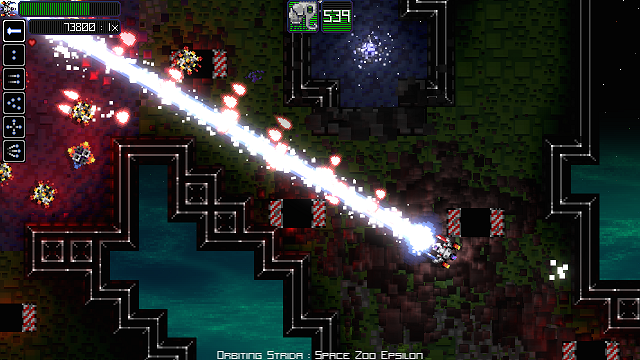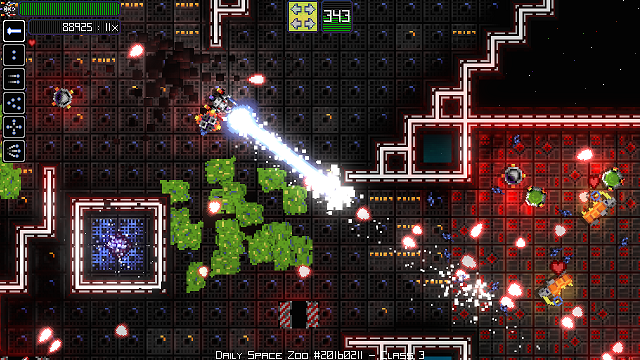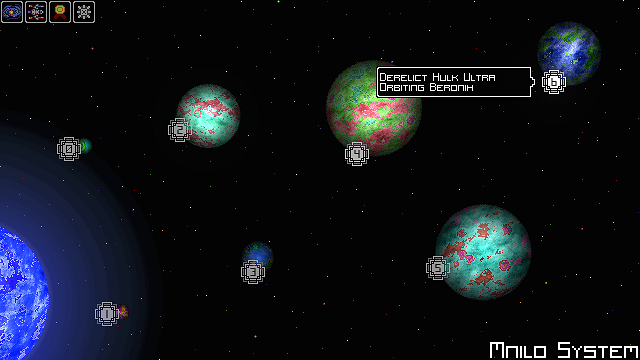Smash/Riot’s new game Dr. Spacezoo or: How I Learned to Stop Shooting and Save the Animals, described as a twin-stick “time attack shoot-em-up jam packed full of grease and gibs, where you rescue exotic space animals from Space Zoos before a corrupted AI activates your ship’s self destruct,” is slated for release sometime in the near future. Version 0.6.1 will soon be available on Steam Early Access and includes such features as full joystick support, both single player and local co-op modes, a boss rush mode, a “daily Spacezoo challenge,” and high score leaderboards.
Why must you stop shooting and save the animals? Well, as the game’s about page explains:
In 2143, Space Zoos are automated facilities run by a centralized AI that was created by Dr. Spacezoo. Historically, the Space Zoo AI provided excellent care and the utmost comfort for all of the exotic space animals. However, the Space Zoo AI was recently corrupted by an unknown entity and is currently starving the exotic space animals and destroying any visitors.
Your mission is to save exotic space animals and get out of the Space Zoo before the Space Zoo AI cracks your ship’s control software and does bad things (mostly explosions). Your ship’s communication signature is coded to look like a sentry bot, but the ruse will be discovered if you make any hostile actions or touch any animals.
If the demo that was available at MAGFest is any indication, the frantic gameplay matches the tone of the story perfectly.
We spoke with Dr. Spacezoo creator Jesse Ozog about the game, its inspiration, the challenges of development, and reducing space animals to grease and gibs.

ZN: What first gave you the idea for Dr. Spacezoo?
JO: Dr. Spacezoo was created during the Indie Quilt game jam back in 2014. The only requirement of the jam was that the game needed to be won or lost within 30 seconds. The result of that game jam was Dr. Spacezoo: a weird shoot-em-up where you rescued a space animals from a space zoo while shooting through the space zoo defense robots. The game’s title ended up being the biggest inspiration for the core animal saving game mechanic.
After finishing the Indie Quilt game jam, I went on to make a few other game prototypes. A few months later I came back to Dr. Spacezoo and decided that I would spend the next 2 years on making Dr. Spacezoo awesome!

ZN: What was your biggest inspiration for the story and the gameplay style?
JO: The inspiration for Dr. Spacezoo‘s title is Stanley Kubrick’s movie Dr. Strangelove or: How I Learned to Stop Worrying and Love the Bomb, which is about a group of politicians and generals trying to stop a nuclear war from happening. In the game, the character of Dr. Spacezoo is inspired by Dr. Strangelove and a generous dash of Professor Farnsworth from Futurama. Also, we must not forget the good Dr. Spacezoo’s faithful space cat Winston (with a PHD in Astrophysics), who is responsible for the advanced weapon research at Dr. Spacezoo Industries. Together, Dr. Spacezoo and Winston send you into the space zoos to rescue as many of the space animals as possible while investigating why the Spacezoo Artificial Intelligence stopped feeding the space animals.
As for the gameplay, I played a lot of shoot-em-ups (e.g. Gradius, Smash TV, Geometry Wars..), the later which have similar twin-stick controls as Dr. Spacezoo. In Dr. Spacezoo I set out to make a really chaotic, bright and glowy, bullet filled shoot-em-up, where you happen to need to save a few animals along the way.
I like to refer to Dr. Spacezoo as a precision twin-stick shoot-em-up, which is a different take on the traditional twin-stick shoot-em-up where you simply blow up everything that moves. Instead, in Dr. Spacezoo, you must be careful to save exotic space animals while fighting your way through hostile space zoo defenses. There is a TON of opportunity for collateral damage (I’m looking at you, drunken homing missiles), which keeps the game entertaining, strategic, and precise.

ZN: Why did you decide to go with procedurally generated levels?
JO: I really like procedurally generated levels for a few reasons. The first reason, and biggest to me, is replay-ability. Since the level generation is seeded off the player’s name, each time you do a fresh start, the game will generate a unique set of levels. Procedurally generated levels are also really good from a development perspective because I haven’t been playing through the same set of hand made levels for 1000s of hours. Everyday I reset the player name so I have a fresh set of levels, which keeps me from simply auto-piloting through the levels and allows me to notice the subtle nuances of each procedurally generated level. Here’s an example of one of the procedurally generated levels with all the debug information enabled:
Inching towards having a good difficulty curve for the #procgen.. pic.twitter.com/WYnhhEf5Ru
— Jesse / Dr. Spacezoo (@SmashRiot) December 18, 2015
The colors represent the level’s difficulty flow, which is very important. I spend a lot of time making subtle tweaks to the difficulty flow to ensure the procedurally generated levels remain fun.
Another reason for using procedurally generated levels is to allow for procedurally generated daily challenges. Every day, each player gets one chance to beat the procedurally generated daily challenge level. I really like the idea of each player getting one chance to show their skill in topping the daily leaderboard on a level nobody has seen before.
Making a good procedural level generator takes a lot more work than making a set of hand-made levels. I’m constantly tweaking the procedural level generation, difficulty flow, enemy type/placement, etc. as I work on other aspects of the game. I wrote up an overview article for the procedural level generation in Dr. Spacezoo if you would like to read more.
In addition to procedurally generating the levels, all of the stars and planets in Dr. Spacezoo are procedurally generated. Originally, I wanted to have about 50 unique planets and stars for the game, but the art requirements for creating them all were really high. Since I’m a better programmer than artist, I made a star and planet generator that creates a unique set of stars and planets for each mission based on the player’s name. Also, I try to post an interesting procedurally generated planet once a day to Twitter.

ZN: What has been your biggest challenge so far in putting Dr. Spacezoo together?
JO: Art is a big challenge for me; character art specifically. As I stated earlier, I consider myself a much better programmer than artist. A few years ago at PAX East, I met an awesome artist named Kahlief Steele that I had been following on Twitter (follow him, he’s rad and makes awesome art!). He’s really done wonderful work transforming rough programmer reference “art” into pixelated magic. Another big challenge for me is time. Dr. Spacezoo is an off-hours project so it’s always a struggle to balance family, work, life, etc. with making games. I love making games, and Dr. Spacezoo is a project I really enjoy working on!

ZN: What’s your favorite thing about the game?
JO: My favorite part of Dr. Spacezoo is the grease and gibs. The enemies, animals, barriers, walls, etc. in Dr. Spacezoo all explode into a shower of grease and component parts that skitter away dropping more grease. I really like the grease splotches for persistence, as each splotch shows you that big battles were fought and some mistakes were made along the way. I also really love all of the crazy space animals, they are all so fun and bouncy (and each has their own unique song). However, of all the space animals, the space cat is my favorite:
@SmashRiot Dr. Spacezoo was a space cat assembling simulator all along! (on Steam, soon) pic.twitter.com/dO1LWKVpeP
— Jesse / Dr. Spacezoo (@SmashRiot) February 17, 2016

ZN: Is there anything else you’d like our readers to know about Dr. Spacezoo?
JO: Dr. Spacezoo is a single player or 2-4 player local co-op game, and is best played with a dual-analog joystick. It will be launching on Steam Early Access for Win/Mac/Linux in March/April 2016 and can be added to your Steam wish list now. You may find out more about Dr. Spacezoo at DrSpacezoo.com and follow me on Twitter for updates!
Whether you save the space animals or reduce them to grease and gibs is your call, you monster!

Dr. Spacezoo will be on Steam Early Access in March/April. More details about the game can be found on its website.






Published: Mar 4, 2016 07:52 am